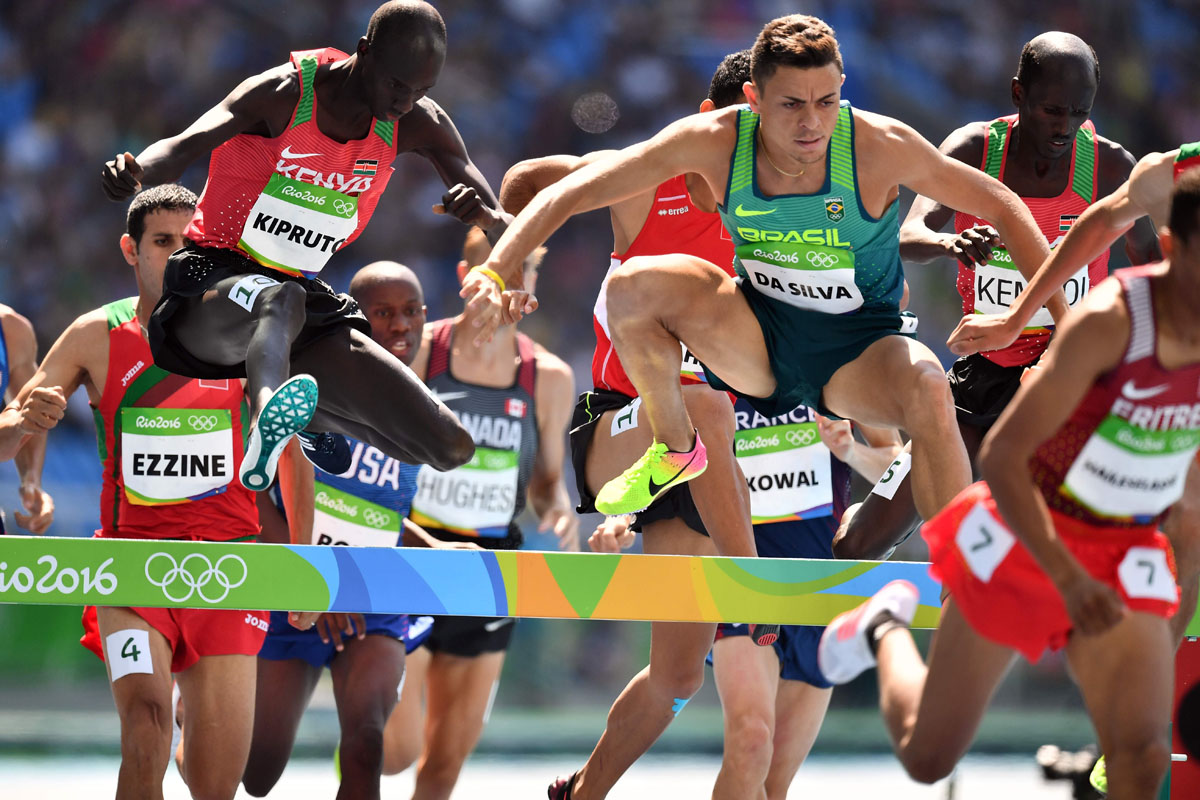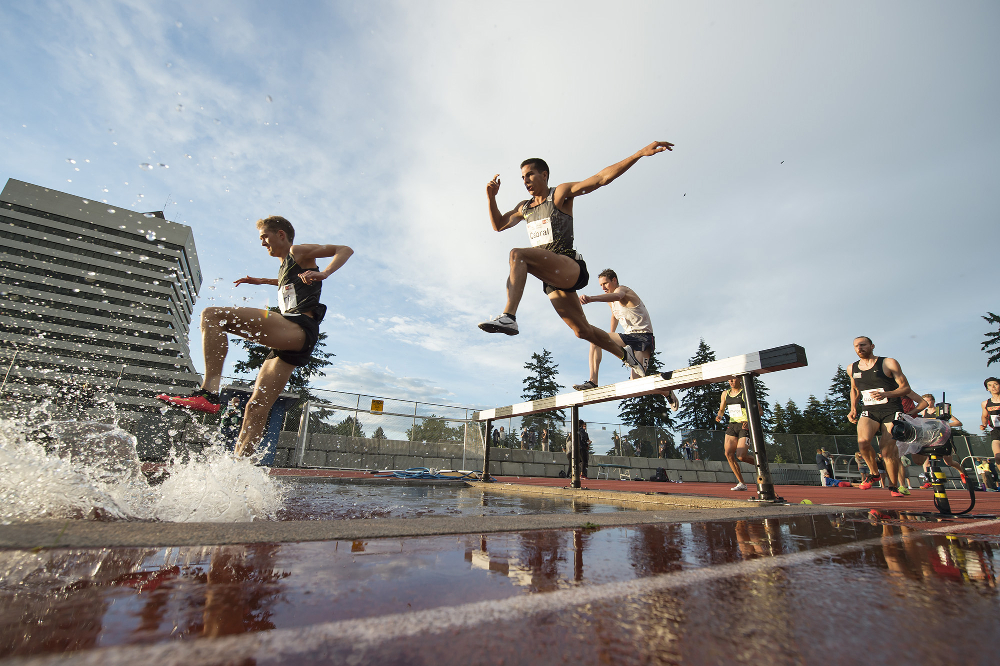History of Steeplechase in the Olympics: Steeplechase Olympics Fall

The steeplechase, a thrilling and demanding race that combines track running with obstacle jumping, has been a part of the Olympic Games since 1900. Its inclusion in the program reflects the enduring appeal of this unique and challenging event.
Evolution of the Steeplechase in the Olympic Games
The steeplechase’s presence in the Olympic Games has evolved over time, with changes in rules, regulations, and the race’s format. The first Olympic steeplechase, held in Paris in 1900, was a 2,500-meter race with 28 obstacles. The obstacles consisted of wooden hurdles and water jumps. In 1904, the distance was increased to 3,200 meters, and the number of obstacles was reduced to 28. In 1908, the distance was standardized to 3,000 meters, with 28 obstacles, a distance that has remained unchanged since then.
The rules and regulations governing the steeplechase have also evolved over time. For example, in the early years of the Olympics, runners were allowed to jump over the obstacles in any way they chose. However, in 1908, the International Amateur Athletic Federation (IAAF) introduced a rule requiring runners to jump over the obstacles with both feet on the ground. This rule was intended to make the race more challenging and to ensure that all runners had to clear the obstacles in the same way.
Notable Steeplechase Races and Athletes
The Olympic steeplechase has witnessed some of the most memorable races and performances in athletics history. One of the most iconic races was the 1960 Olympic steeplechase, where the Soviet Union’s Vladimir Kuts won the race in a world record time of 8:31.2. Kuts’s performance was considered a remarkable feat of endurance and athleticism.
Another notable steeplechase race was the 1980 Olympic steeplechase, where the Polish runner, Bronisław Malinowski, won the race in a time of 8:09.70. Malinowski’s victory was considered a significant achievement, as he had been training in secret during the Soviet-led boycott of the 1980 Olympics. His win highlighted the resilience and dedication of athletes during a politically turbulent time.
Key Moments and Milestones
The Olympic steeplechase has witnessed several key moments and milestones that have shaped the discipline’s presence in the Games. One of the most significant moments was the introduction of the water jump in 1900. The water jump added an element of danger and excitement to the race, making it more challenging and visually appealing. The water jump has become a signature feature of the steeplechase, and it is one of the most popular aspects of the race for spectators.
Another key moment in the history of the Olympic steeplechase was the establishment of the IAAF’s rules governing the race. These rules, which were introduced in 1908, have ensured that the steeplechase is a fair and challenging event for all runners. The rules have also helped to standardize the race, making it a more consistent and predictable event.
Changes in the Steeplechase
The steeplechase has undergone some significant changes in recent years. One of the most notable changes has been the increase in the number of women participating in the event. In the early years of the Olympics, the steeplechase was only open to men. However, in 2008, the International Olympic Committee (IOC) approved the inclusion of the women’s steeplechase in the Olympic Games. This decision was a significant step forward for women’s athletics, and it has led to a surge in participation in the event.
Another change that has affected the steeplechase in recent years has been the development of new training methods and techniques. These methods have helped athletes to improve their speed, endurance, and obstacle-clearing abilities. As a result, the times in the steeplechase have been steadily decreasing in recent years.
Impact of the Steeplechase
The steeplechase has had a significant impact on the Olympic Games. The event has become a popular spectator sport, and it has helped to raise the profile of athletics in the Olympics. The steeplechase has also served as a platform for athletes to showcase their athleticism, endurance, and determination. The event has been a source of inspiration for many athletes, and it has helped to promote the values of sportsmanship, fair play, and excellence.
Steeplechase at the Tokyo 2020 Olympics

The Tokyo 2020 Olympics witnessed thrilling steeplechase races in both the men’s and women’s categories, showcasing the exceptional skills and endurance of the world’s best athletes. This section will delve into the performances of top athletes, the strategies they employed, and the challenges they encountered in the unique context of the Tokyo Games.
Performance of Top Athletes, Steeplechase olympics fall
The men’s steeplechase final saw a fierce competition between several top contenders. The Kenyan duo of Conseslus Kipruto, the reigning Olympic champion, and Benjamin Kigen, a rising star, were considered favorites. However, Soufiane El Bakkali of Morocco, the 2019 World Champion, emerged victorious with a time of 8:08.90, a new Olympic record. Kipruto finished in second place, while Kigen took the bronze.
In the women’s steeplechase final, Peruth Chemutai of Uganda, a relatively unknown athlete before the Games, stunned the world with a dominant performance, winning gold with a time of 9:01.45. Courtney Frerichs of the United States, the reigning world silver medalist, secured silver, while Hyvin Kiyeng of Kenya, the 2016 Olympic silver medalist, took the bronze.
Strategies and Tactics
Steeplechase races require a combination of speed, endurance, and tactical awareness. Athletes must balance their efforts to maintain a strong pace while navigating the water jumps and hurdles. The Tokyo Games saw athletes employing various strategies to gain an advantage.
- Pacing and Positioning: Athletes often try to position themselves strategically within the pack, aiming to avoid unnecessary energy expenditure while staying close to the leaders. This allows them to conserve energy for the final stages of the race.
- Water Jump Technique: The water jumps are a key element of the steeplechase, and athletes employ different techniques to clear them efficiently. Some athletes prefer a high-stepping approach, while others use a running jump, minimizing the impact on their bodies.
- Hurdle Clearance: The hurdles are another challenge in the steeplechase, and athletes use different techniques to clear them. Some athletes prefer a high-knee approach, while others use a more powerful stride, depending on their individual strengths and preferences.
- Final Sprint: The final lap of the steeplechase is often a race to the finish line. Athletes with strong finishing speeds can use this advantage to overtake competitors in the closing stages.
Challenges and Opportunities
The Tokyo Olympics presented unique challenges and opportunities for steeplechase athletes.
- Heat and Humidity: The hot and humid conditions in Tokyo posed a significant challenge for athletes, especially during the final stages of the race. Athletes had to adjust their training and race strategies to cope with the demanding climate.
- Spectator Restrictions: Due to the COVID-19 pandemic, spectator attendance at the Games was limited. While this may have impacted the atmosphere, it also provided a less distracting environment for athletes to focus on their performance.
- Global Competition: The Tokyo Games brought together the world’s best steeplechase athletes, creating a highly competitive field. This presented both challenges and opportunities for athletes, as they had to perform at their best to achieve success.
Steeplechase olympics fall – The steeplechase at the Olympics is always a nail-biter, especially when you see those crazy hurdles! Totally different vibe than the chill atmosphere at Quincy Hall , which is like the ultimate hangout spot in town. Speaking of chill, I’m thinking of grabbing some ice cream after watching the steeplechase, gotta keep those energy levels up for the rest of the games!
Steeplechase at the Olympics is always a wild ride, with those crazy water jumps and barriers. It’s a high-risk sport, and sometimes things go wrong, like when Girma fell hard during a race. That kind of fall can really shake things up, but it’s a reminder of how much these athletes put on the line for that gold medal.